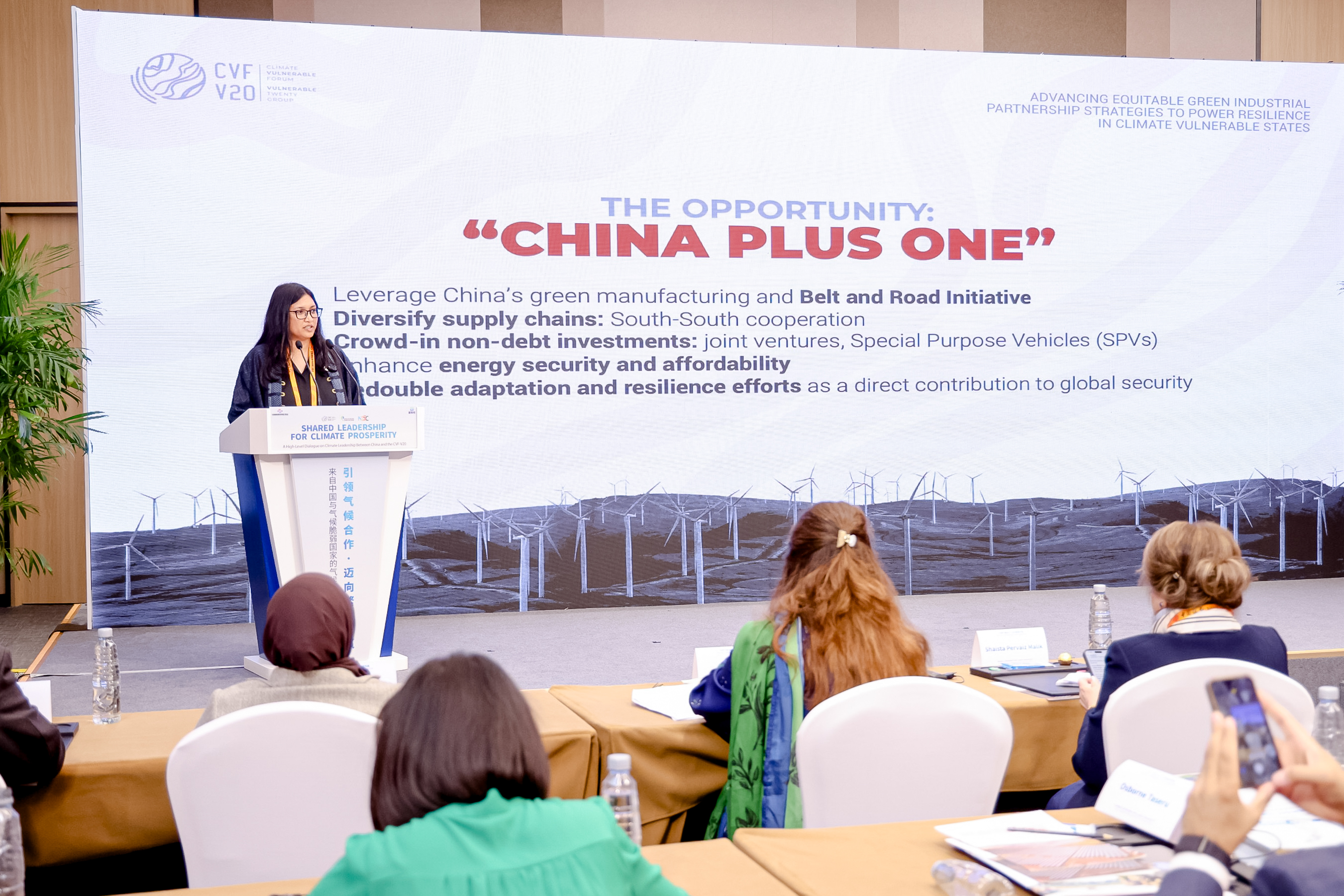Beijing, China –With global temperatures pushing past 1.5°C, an insight piece and a report released today in Beijing outline how climate-vulnerable countries can accelerate their renewable energy transition through cooperation with China.
The insight piece, “Advancing Equitable Green Industrial Partnership Strategies to Power Resilience in Climate Vulnerable States,” published by the Climate Vulnerable Forum and V20 Finance Ministers (CVF-V20) Secretariat,maps out how equitable renewable trade with China can drive economic modernization, resilience, and prosperity across the 74 CVF-V20 economies.
“The greening of the Belt and Road Initiative presents an opportunity to leverage China's manufacturing capacity and its development strategies to advance energy security and energy affordability in climate-vulnerable developing countries. For V20 members, particularly those with high debt servicing costs and limited access to concessional capital, this presents an opportunity to crowd in non-debt creating investments through joint ventures and special purpose vehicles, among others, ultimately grounded in and driven by South-South cooperation,” the insight piece stated.
The Empowered with Green Energy, for Climate Prosperity: The Belt and Road Initiative Renewable Energy Investment Report produced by the National Center for Climate Change Strategy and International Cooperation (NCSC) provides a comprehensive assessment of how climate-vulnerable economies and China can align policies, investments, and technologies to accelerate both resilience and the energy transition.
As stated in the report, “the policies, standards and regulations governing specific BRI projects should be coordinated. Consensus and joint initiatives should be adopted to address difficulties and challenges collectively. In the field of new energy investment, it is crucial to promote innovative financing mechanisms and explore new models, leveraging the full potential of government departments and policy financial institutions.”
The insight piece and report were launched today at the Shared Leadership for Climate Prosperity: A High-Level Dialogue on Climate Leadership between China and the CVF-V20 organized by the CVF-V20 Secretariat, NCSC, and People of Asia for Climate Solutions (PACS), as a side event of the Global Trade in Services Summit. Together, theycreate an unprecedented roadmap linking China’s industrial capacity with the urgent needs of nations on the frontlines of the climate crisis.
“Climate-vulnerable countries are not simply at risk. They are already taking lead of the global transition towards resilience and green growth,” said Sara Jane Ahmed, CVF-V20 Secretariat Managing Director and V20 Finance Adviser. “Partnerships with China that must be equitable, people-centered, and designed to deliver shared prosperity can usher in a bold new era of South-South cooperation on renewable energy,” she added.

Sara Jane Ahmed, Managing Director of the CVF-V20, calls for the creation of a “people-centered and goal-oriented” green partnership framework to advance cooperation in areas such as green special economic zones, skills transfer, and joint manufacturing.
Despite contributing only 7.3% of global emissions, CVF-V20 countries are among the hardest hit by intensifying disasters and extreme weather events. In Pakistan, since late June 2025, intense monsoon rains, cloudbursts, and dam water releases have displaced over 2 million people, submerged nearly 4,000 villages, and killed at least 61 people as flooding continues to devastate central regions.
Meanwhile in the Philippines, an intense thunderstorm last August dumped rainfall equivalent to five days’ worth, flooding large parts of Metro Manila, overwhelming drainage systems, and displacing thousands. In China, northern regions have just endured the hottest summer since 1961 paired with the longest rainy season in decades.
Achieving resilience and modernization are inseparable goals: to protect communities, economies must modernize and to modernize, resilience must be built in. Climate Prosperity Plans (CPPs), pioneered by the V20, offer a pathway forward, providing fully costed investment strategies that transform risks into opportunities.
China’s role is pivotal. Already the world leader in solar, wind, and battery storage, China’s Green Belt and Road Initiative and expanding trade networks can provide climate-vulnerable economies with affordable access to clean energy technologies and investment. At the Global Trade in Services Summit in Beijing this week, Chinese Vice Premier Ding Xuexiang reaffirmed China’s commitment to work with other countries, proposing to “advance common prosperity through mutually beneficial cooperation.” His remarks reinforce the reports’ findings that China–V20 renewable energy cooperation can deliver shared growth and resilience.
The “China Plus One” strategy outlined in the CVF-V20 insight piece envisions diversified supply chains, joint ventures, and special purpose vehicles that crowd in private finance while reducing debt burdens. Meanwhile, the NCSC study highlights the potential for policy innovation, regional cooperation, and enhanced technology transfer to scale renewable deployment across Asia, Africa, and beyond.

Xiaojun Wang, Executive Director of People of Asia for Climate Solutions (PACS), says that bringing together China and the CVF-V20 countries represents a global force for cooperation.
“We have almost 40% of the world population when we put China and CVF-V20 countries together,” said Xiaojun Wang, Executive Director of PACS. “This is not only about megawatts and markets. It is about protecting and improving livelihoods, empowering communities, and ensuring no one is left behind in the energy transition.”
Trade data already show the scale of the opportunity. Between 2015 and 2023, renewable energy accounted for only 5.38% of total trade between China and V20 countries, heavily concentrated in South and Southeast Asia. Vast untapped potential remains in Africa, Latin America, the Caribbean, and the Pacific. Expanding China’s zero-tariff policies, supporting pooled procurement platforms, and strengthening training and technology transfer could unlock billions in trade and investment while creating green jobs across multiple regions.
Released just months before COP30, the insight piece and report carry a timely message: equitable green industrial cooperation between China and climate-vulnerable economies is not only feasible but vital to meet climate targets, advance the Paris Agreement, and deliver on the Sustainable Development Goals.
Media Contact:
KJ Galang
Communications Associate, CVF-V20 Secretariat
Leovy C. Ramirez (she/her)
Communications Officer, People of Asia for Climate Solutions